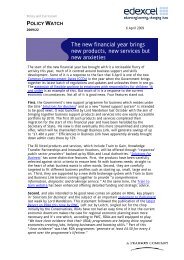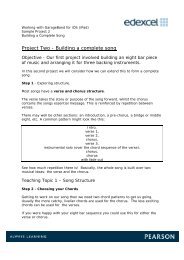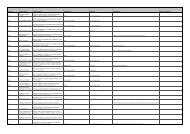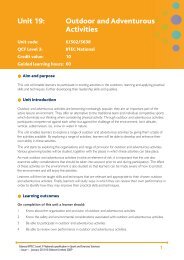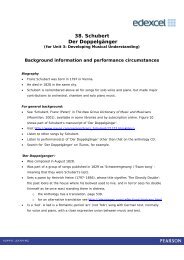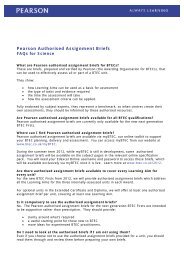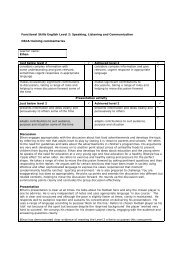Unit 20: Client Side Customisation of Web Pages - Edexcel
Unit 20: Client Side Customisation of Web Pages - Edexcel
Unit 20: Client Side Customisation of Web Pages - Edexcel
Create successful ePaper yourself
Turn your PDF publications into a flip-book with our unique Google optimized e-Paper software.
<strong>Unit</strong> <strong>20</strong>:<br />
<strong>Client</strong> <strong>Side</strong> <strong>Customisation</strong> <strong>of</strong><br />
<strong>Web</strong> <strong>Pages</strong><br />
<strong>Unit</strong> code:<br />
QCF Level 3:<br />
Credit value: 10<br />
Guided learning hours: 60<br />
Aim and purpose<br />
Y/601/7660<br />
BTEC National<br />
The aim <strong>of</strong> this unit is to ensure learners understand the fundamentals <strong>of</strong> cascading style sheets and scripting<br />
languages and are able to develop the skills required to implement web pages using these tools.<br />
<strong>Unit</strong> introduction<br />
There is an increasing expectation that website design will adhere to web standards and that websites will<br />
consist <strong>of</strong> sophisticated, interactive web pages. This requires website designers and creators to be familiar<br />
with standard tools, techniques and languages in order to create such websites. In particular, web standards<br />
are beginning to expect mark-up to be done in XHTML, layout to be controlled by cascading style sheets<br />
(CSS) and client side interactivity by a scripting language such as JavaScript or VBScript.<br />
XHTML is a stricter version <strong>of</strong> HTML and adheres to XML standards. CSS and JavaScript or VBScript are<br />
powerful scripting languages used to create sophisticated layouts and interactivity on web pages, respectively.<br />
A key feature <strong>of</strong> CSS Java/VBScript is that the script (code) is stored on the clients’ system rather than on<br />
host server systems. As they do not need to interact with a web server, this can save resources and network<br />
bandwidth. CSS are capable <strong>of</strong> creating complex, sophisticated layouts which are easy to maintain and update<br />
across the whole website or individual pages. Java/VBScript is able to validate information that users enter into<br />
a form before it is sent to a web server for processing.<br />
This specialist unit is an introduction to the creation <strong>of</strong> web pages with some compliance with web standards.<br />
Layout will, therefore, be controlled by CSS, and interactivity controlled by a client side scripting language<br />
such as JavaScript or VBScript. Learners will develop an understanding <strong>of</strong> the fundamental characteristics <strong>of</strong><br />
CSS and a chosen scripting language. Learners will develop web pages with sophisticated layouts in which<br />
calculations can be performed by combining the two tools.<br />
Learning outcomes<br />
On completion <strong>of</strong> this unit a learner should:<br />
1 Understand the fundamentals <strong>of</strong> cascading style sheets (CSS)<br />
2 Understand the fundamentals <strong>of</strong> scripting languages<br />
3 Be able to control the layout <strong>of</strong> web pages using CSS<br />
4 Be able to create interactive web pages.<br />
<strong>Edexcel</strong> BTEC Level 3 Nationals specification in Information Technology<br />
1<br />
– Issue 3 – September <strong>20</strong>10 © <strong>Edexcel</strong> Limited <strong>20</strong>10
<strong>Unit</strong> content<br />
1 Understand the fundamentals <strong>of</strong> cascading style sheets (CSS)<br />
Characteristics <strong>of</strong> CSS: CSS frameworks; box model eg width, margins, padding, border, content area,<br />
inline, block; selectors eg type, class, ID; accessing CSS from HTML eg in-line, embedded, external, user<br />
Uses <strong>of</strong> CSS: uses eg background colour, background images, formatting text, borders, padding, heading<br />
styles, positioning elements, creating columns; advantages<br />
2 Understand the fundamentals <strong>of</strong> scripting languages<br />
Characteristics <strong>of</strong> scripting languages: nature <strong>of</strong> language eg object oriented, event driven; objects;<br />
methods; handling events; hiding scripts; security issues eg reading, writing, client files, opening/closing<br />
user windows, reading information; including scripts inside HTML<br />
Uses <strong>of</strong> a scripting language: eg alerts, confirming choices, prompting the user, redirecting the user,<br />
browser detection, creating rollovers, checking/validating input, handling forms, maintaining cookies<br />
Scripting language constructs: syntax eg dot operator, values, variables, operators, assignment,<br />
comparisons; loops eg for, for/in, do/while; decision making eg if, if/else, switch/case; functions (calling,<br />
parameter passing); handling events eg onfocus, onload, onblur, onmouseover; methods eg write(),<br />
click(), open(), selected(); properties eg name, width, ID, value<br />
3 Be able to control the layout <strong>of</strong> web pages using CSS<br />
Design: layout planned using appropriate graphical or other tool<br />
Headings: styling eg adding colour, font size, font weight, background image; spacing eg applying padding,<br />
margins, borders<br />
Lists: styling tags; hover effect; horizontal navigation; vertical navigation<br />
Links and pseudo classes: setting pseudo class order; adding background images; styling eg removing<br />
underlines, adding borders, increasing active area<br />
4 Be able to create interactive web pages<br />
Script requirements: inputs; outputs; processing<br />
Design script: use <strong>of</strong> appropriate tools eg flowchart, pseudo code<br />
Implement script: appropriate objects eg properties, methods; writing eg required functions; creation <strong>of</strong><br />
web pages eg rollovers, clocks, calendars, client-side calculations, forms validation, mouse movement<br />
followers<br />
Good practice: eg comments in the script, correct indentation, naming variables<br />
Testing: layout matches design; interactivity working; check using different browsers eg Internet Explorer,<br />
Firefox, Opera, Chrome, Safari<br />
2<br />
<strong>Edexcel</strong> BTEC Level 3 Nationals specification in Information Technology<br />
– Issue 3 – September <strong>20</strong>10 © <strong>Edexcel</strong> Limited <strong>20</strong>10
Assessment and grading criteria<br />
In order to pass this unit, the evidence that the learner presents for assessment needs to demonstrate that<br />
they can meet all the learning outcomes for the unit. The assessment criteria for a pass grade describe the<br />
level <strong>of</strong> achievement required to pass this unit.<br />
Assessment and grading criteria<br />
To achieve a pass grade the<br />
evidence must show that the<br />
learner is able to:<br />
P1<br />
P2<br />
P3<br />
P4<br />
P5<br />
explain how HTML files<br />
access CSS<br />
explain the features <strong>of</strong> the<br />
box model for CSS<br />
explain the fundamentals <strong>of</strong> a<br />
scripting language<br />
design web pages using CSS<br />
to control layout<br />
[CT3]<br />
create interactive web pages<br />
using CSS and a scripting<br />
language<br />
[CT1]<br />
To achieve a merit grade the<br />
evidence must show that, in<br />
addition to the pass criteria,<br />
the learner is able to:<br />
M1 assess different<br />
implementation styles <strong>of</strong> CSS<br />
M2 discuss how a scripting<br />
language can improve<br />
functionality<br />
M3 employ good practice in the<br />
design and implementation <strong>of</strong><br />
web pages.<br />
To achieve a distinction grade<br />
the evidence must show that,<br />
in addition to the pass and<br />
merit criteria, the learner is<br />
able to:<br />
D1<br />
explore how web pages<br />
using scripts are implemented<br />
in different browsers<br />
[IE2]<br />
P6 test interactive web pages. D2 evaluate the web pages and<br />
discuss improvements.<br />
[RL5]<br />
PLTS: This summary references where applicable, in the square brackets, the elements <strong>of</strong> the personal,<br />
learning and thinking skills applicable in the pass criteria. It identifies opportunities for learners to demonstrate<br />
effective application <strong>of</strong> the referenced elements <strong>of</strong> the skills.<br />
Key<br />
IE – independent enquirers<br />
RL – reflective learners<br />
SM – self-managers<br />
CT – creative thinkers<br />
TW – team workers<br />
EP – effective participators<br />
<strong>Edexcel</strong> BTEC Level 3 Nationals specification in Information Technology<br />
– Issue 3 – September <strong>20</strong>10 © <strong>Edexcel</strong> Limited <strong>20</strong>10<br />
3
Essential guidance for tutors<br />
Delivery<br />
Delivery starts with a study <strong>of</strong> the characteristics <strong>of</strong> CSS through whole-class teaching including tutor<br />
demonstrations <strong>of</strong> practical elements, which lead into learner exercises.<br />
Care should be taken to cover sufficient ground to facilitate learners providing evidence for associated criteria.<br />
Ensure that implementation styles are covered (including how they are called from HTML) as well as methods<br />
<strong>of</strong> accessing external CSS (at least one from HTML).<br />
There must also be in-depth coverage <strong>of</strong> the box model for CSS by discussion and, if possible, demonstration<br />
and learner exercise.<br />
These elements must be treated seriously because they contain a lot <strong>of</strong> information which is the basis <strong>of</strong><br />
several criteria in the assessment. The tutor should not underestimate the amount <strong>of</strong> time this is likely to<br />
require.<br />
Any scripting language which can fulfil the requirements <strong>of</strong> the criteria may be used. The unit does not<br />
recommended which is more acceptable and it is entirely a matter for tutors and centres. The first topic in this<br />
group deals with characteristics <strong>of</strong> scripting languages which can be delivered using a mixture <strong>of</strong> whole-class<br />
teaching, handouts, quizzes and discussion groups. This is followed by uses <strong>of</strong> scripting language, using similar<br />
techniques for delivery.<br />
Practical application <strong>of</strong> scripting, considering constructs, designing, implementing and good practice, can all be<br />
delivered by tutor demonstration backed up by informative commentary and followed by learner exercises.<br />
Having developed the skills required to undertake practical work, elements <strong>of</strong> what is considered to be good<br />
practice are introduced.<br />
The next group <strong>of</strong> topics <strong>of</strong> delivery are all related to the practical application <strong>of</strong> CSS. Design, styling<br />
(in various forms), spacing, hover effect, navigation pseudo-classes, and background images can all be<br />
demonstrated and practised.<br />
Learners should look at the design stage first. It is recommended that learners receive guidance to ensure that<br />
their designs are suitable and will transfer into a workable design. Tutors should also make sure that designs<br />
can be created with the available tools.<br />
The next element <strong>of</strong> the unit is to combine the learning on scripting and on CSS to learn how to create and<br />
test a microsite that uses both. Learners could work individually, drawing on the knowledge they have gained<br />
in the rest <strong>of</strong> the unit.<br />
Finally, learners test and review web pages containing CSS, once again through tutor demonstration and<br />
learner exercise with some tutor-led discussion to emphasise the important aspects.<br />
4<br />
<strong>Edexcel</strong> BTEC Level 3 Nationals specification in Information Technology<br />
– Issue 3 – September <strong>20</strong>10 © <strong>Edexcel</strong> Limited <strong>20</strong>10
Outline learning plan<br />
The outline learning plan has been included in this unit as guidance and can be used in conjunction with the<br />
programme <strong>of</strong> suggested assignments.<br />
The outline learning plan demonstrates one way in planning the delivery and assessment <strong>of</strong> this unit.<br />
Topic and suggested assignments/activities and/assessment<br />
Introduction to the unit<br />
Fundamentals <strong>of</strong> CSS:<br />
●<br />
●<br />
whole-class exercise – tutor presentation on the characteristics <strong>of</strong> CSS<br />
directed research – class activity on the uses <strong>of</strong> CSS.<br />
Assignment 1 – Features <strong>of</strong> CSS<br />
Fundamentals <strong>of</strong> a scripting language:<br />
●<br />
●<br />
●<br />
whole-class exercise – tutor presentation on the characteristics <strong>of</strong> scripting languages<br />
directed research – what are the main uses <strong>of</strong> scripting languages?<br />
individual exercise – learn the different scripting language constructs.<br />
Assignment 2 – Using CSS<br />
Laying out a web page using CSS:<br />
●<br />
●<br />
●<br />
whole-class exercise – tutor presentation on how to style headings for use in web pages<br />
individual exercise – how can list tags be formatted using CSS?<br />
directed research – learn CSS pseudo-classes and how they can be used on hyperlinks.<br />
Creating an interactive web page:<br />
●<br />
●<br />
●<br />
●<br />
●<br />
whole-class exercise – tutor presentation on script requirements<br />
individual exercise – create design scripts<br />
individual exercise – implement a working script<br />
whole-class exercise – understanding good practice in coding<br />
individual exercise – be able to test and review a web page which uses JavaScript and CSS.<br />
Assignment 3 – Using Scripting<br />
Assessment<br />
Suggested Assignment 1 – Features <strong>of</strong> CSS<br />
The suggested evidence for this assignment is the production <strong>of</strong> information leaflet(s).<br />
Criterion P1 is a straightforward explanation <strong>of</strong> how CSS code can be linked to an HTML file.<br />
Criterion P2 is another straightforward explanation, in this case <strong>of</strong> a box model for CSS, together with the<br />
related selectors and how they are used. Illustrations/diagrams should be used to support the explanation.<br />
For M1, the learner must be able to assess different implementation styles for CSS. The descriptions need to<br />
be detailed and show that the learner has fully comprehended what the different implementations can be, and<br />
why they should be used for a particular purpose.<br />
<strong>Edexcel</strong> BTEC Level 3 Nationals specification in Information Technology<br />
– Issue 3 – September <strong>20</strong>10 © <strong>Edexcel</strong> Limited <strong>20</strong>10<br />
5
Suggested Assignment 2 – Using CSS<br />
To vary assessment, a presentation is suggested for this assignment but any method can be used.<br />
Criterion P3 is an explanation <strong>of</strong> the main features <strong>of</strong> the chosen scripting language. Learners should<br />
endeavour to include something about all <strong>of</strong> the prescriptive elements <strong>of</strong> LO2. Since the unit is fundamentally<br />
about web pages it is suggested that a series <strong>of</strong> web pages would be suitable evidence<br />
M2 is concerned with how script languages improve the functionality <strong>of</strong> web pages. Learner must show that<br />
they understand how scripting works in a front-end context, how it is commonly used on the web; analytics,<br />
client-side calculation, etc.<br />
D1 requires an exploration <strong>of</strong> how web pages using scripts are implemented in different browsers. Learners<br />
will need to research and include examples as part <strong>of</strong> their explanation.<br />
Suggested Assignment 3 – Using Scripting<br />
For P4, learners must methodically and systematically design web pages that make use <strong>of</strong> both CSS and<br />
scripting languages using CSS to control layout. This can be evidenced by the production <strong>of</strong> a design<br />
document.<br />
For P5, learners must then take their design and use it to actually create a micro-site, programming in the CSS<br />
and scripting elements. This can be evidenced by tutor observation and printouts/screen dumps.<br />
For P6, learners must test the site, documenting a systematic approach as evidence that they have completed<br />
the task.<br />
M3 should be evidenced as a natural extension <strong>of</strong> P5 using an annotated program code.<br />
D2 is an evaluation <strong>of</strong> the learner’s micro-site, which should include suggestions for improvements.<br />
Programme <strong>of</strong> suggested assignments<br />
The table below shows a programme <strong>of</strong> suggested assignments that cover the pass, merit and distinction<br />
criteria in the assessment and grading grid. This is for guidance and it is recommended that centres either<br />
write their own assignments or adapt any <strong>Edexcel</strong> assignments to meet local needs and resources.<br />
Criteria covered Assignment title Scenario Assessment method<br />
P1, P2, M1 Features <strong>of</strong> CSS You work for a website<br />
development company<br />
which has asked you to<br />
produce some information<br />
on CSS.<br />
P3, M2, D1 Using Scripting The company also wants<br />
a similar briefing on how<br />
scripting can be used to<br />
improve their web pages’<br />
functionality.<br />
P4-P6, M3, D2 Using CSS and Scripting The company would like a<br />
micro-site to demonstrate<br />
practically the use <strong>of</strong> scripting<br />
and CSS.<br />
Information leaflets<br />
Presentation<br />
Set <strong>of</strong> web pages<br />
Tutor observation<br />
6<br />
<strong>Edexcel</strong> BTEC Level 3 Nationals specification in Information Technology<br />
– Issue 3 – September <strong>20</strong>10 © <strong>Edexcel</strong> Limited <strong>20</strong>10
Links to National Occupational Standards, other BTEC units, other BTEC<br />
qualifications and other relevant units and qualifications<br />
This unit forms part <strong>of</strong> the BTEC in IT sector suite. This unit has particular links with the following unit titles in<br />
the IT suite:<br />
Level 2 Level 3 Level 4<br />
<strong>Unit</strong> 17: <strong>Web</strong>site Development <strong>Unit</strong> 27: <strong>Web</strong> Server Scripting <strong>Web</strong>site Design<br />
<strong>Unit</strong> 34: <strong>Web</strong>site Production<br />
<strong>Web</strong> Applications Development<br />
This unit maps to some <strong>of</strong> the underpinning knowledge from the following areas <strong>of</strong> competence in the<br />
Level 2 National Occupational Standards for IT (ProCom):<br />
●<br />
●<br />
4.6 Human Computer Interaction/Interface (HCI) Design<br />
5.2 S<strong>of</strong>tware Development.<br />
Essential resources<br />
Learners will need access to a suitable integrated development environment (IDE) in which to write scripts eg<br />
Dreamweaver, FrontPage, Notepad. They will also need access to an appropriate computer, the internet and<br />
to a variety <strong>of</strong> different web browsers to allow cross-browser testing.<br />
Employer engagement and vocational contexts<br />
This unit is an opportunity for a real client to become involved with a defined requirement.<br />
Indicative reading for learners<br />
Textbooks<br />
Bartlett K – Sams Teach Yourself CSS in 24 Hours, 3rd Edition (Sams, <strong>20</strong>10) ISBN-10 06723310<strong>20</strong>,<br />
ISBN-13 978-0672331022<br />
Castro E – HTML, XHTML, and CSS: Visual QuickStart Guide, 6th Edition (Peachpit Press, <strong>20</strong>06)<br />
ISBN-10 0321430840 ISBN-13 978-0321430847<br />
Cederholm D – <strong>Web</strong> Standards Solutions: The Markup and Style Handbook, 2nd Edition (FRIENDS OF ED,<br />
<strong>20</strong>09) ISBN-10 1430219<strong>20</strong>3, ISBN-13 978-1430219<strong>20</strong>0<br />
Meyer E – CSS Pocket Reference, 3rd Edition (O’Reilly, <strong>20</strong>07) ISBN-10 0596515057,<br />
ISBN-13 978-0596515058<br />
Negrino T and Smith D – JavaScript for the World Wide <strong>Web</strong>, 5th Edition (Peachpit Press, <strong>20</strong>05)<br />
ISBN-10 0321423348, ISBN-13 978-0321423344<br />
Pollock J – JavaScript: A Beginner’s Guide, 3rd Edition (McGraw-Hill Osborne, <strong>20</strong>09) ISBN-10 0071632956,<br />
ISBN-13 978-0071632959<br />
Schmitt C – CSS Cookbook, 3rd Edition (O’Reilly, <strong>20</strong>09) ISBN-10 059615593X, ISBN-13 978-0596155933<br />
Shea D and Holzschlag M – The Zen <strong>of</strong> CSS Design: Visual Enlightenment for the <strong>Web</strong> (Peachpit Press, <strong>20</strong>05)<br />
ISBN-10 0321303474 ISBN-13 978-0321303479<br />
Weakley R – Sams Teach Yourself CSS in 10 Minutes (Sams, <strong>20</strong>05) ISBN-10 0672327457,<br />
ISBN-13 978-0672327452<br />
<strong>Edexcel</strong> BTEC Level 3 Nationals specification in Information Technology<br />
– Issue 3 – September <strong>20</strong>10 © <strong>Edexcel</strong> Limited <strong>20</strong>10<br />
7
<strong>Web</strong>sites<br />
www.csszengarden.com<br />
www.javascriptworld.com<br />
www.w3schools.com/css/default.asp<br />
Delivery <strong>of</strong> personal, learning and thinking skills<br />
The table below identifies the opportunities for personal, learning and thinking skills (PLTS) that have been<br />
included within the pass assessment criteria <strong>of</strong> this unit.<br />
Skill<br />
Independent enquirers<br />
Creative thinkers<br />
Reflective learners<br />
When learners are …<br />
planning and carrying out research to explore how web pages using scripts are<br />
implemented in different browsers<br />
connecting their own and others’ ideas when designing web pages using CSS to<br />
control layout<br />
generating ideas and exploring possibilities when creating interactive web pages<br />
evaluating experiences and informing future progress when assessing web pages<br />
and discussing improvements.<br />
Although PLTS are identified within this unit as an inherent part <strong>of</strong> the assessment criteria, there are further<br />
opportunities to develop a range <strong>of</strong> PLTS through various approaches to teaching and learning.<br />
Skill<br />
Self-managers<br />
When learners are …<br />
organising time and resources to design, create and test web pages.<br />
8<br />
<strong>Edexcel</strong> BTEC Level 3 Nationals specification in Information Technology<br />
– Issue 3 – September <strong>20</strong>10 © <strong>Edexcel</strong> Limited <strong>20</strong>10
Functional Skills – Level 2<br />
Skill<br />
ICT – Using ICT<br />
Plan solutions to complex tasks by analysing<br />
the necessary stages<br />
Select, interact with and use ICT systems<br />
safely and securely for a complex task in nonroutine<br />
and unfamiliar contexts<br />
ICT – Developing, presenting and<br />
communicating information<br />
Enter, develop and refine information using<br />
appropriate s<strong>of</strong>tware to meet requirements<br />
<strong>of</strong> a complex task<br />
Combine and present information in ways<br />
that are fit for purpose and audience<br />
Evaluate the selection, use and effectiveness<br />
<strong>of</strong> ICT tools and facilities used to present<br />
information<br />
When learners are …<br />
designing web pages for a specific purpose<br />
creating interactive web pages<br />
creating interactive web pages using CSS and a scripting language<br />
producing a briefing on the use <strong>of</strong> web page scripting<br />
evaluating interactive web pages.<br />
<strong>Edexcel</strong> BTEC Level 3 Nationals specification in Information Technology<br />
– Issue 3 – September <strong>20</strong>10 © <strong>Edexcel</strong> Limited <strong>20</strong>10<br />
9







